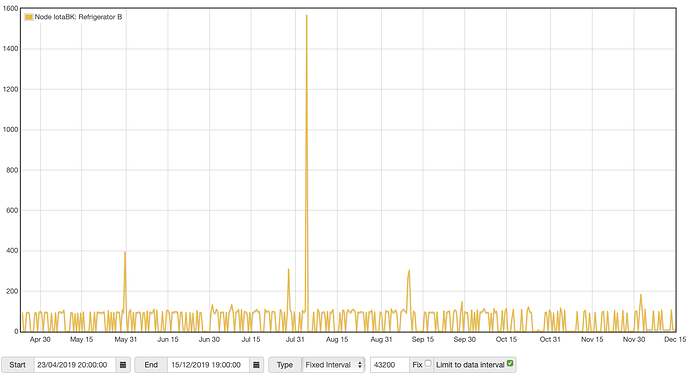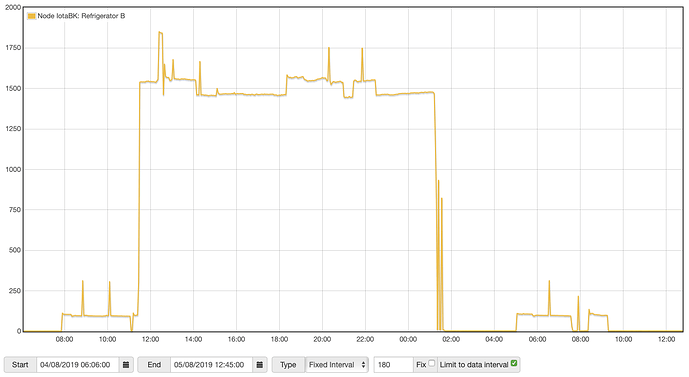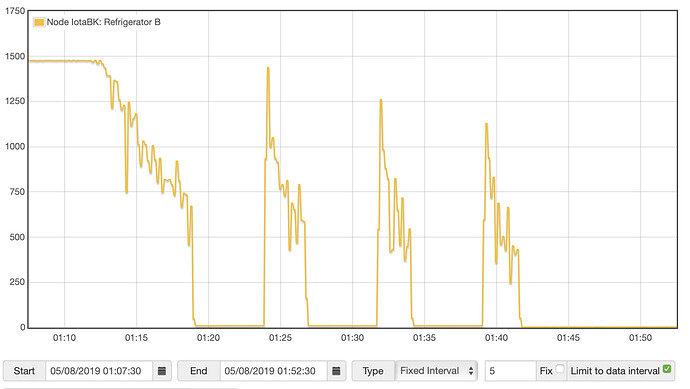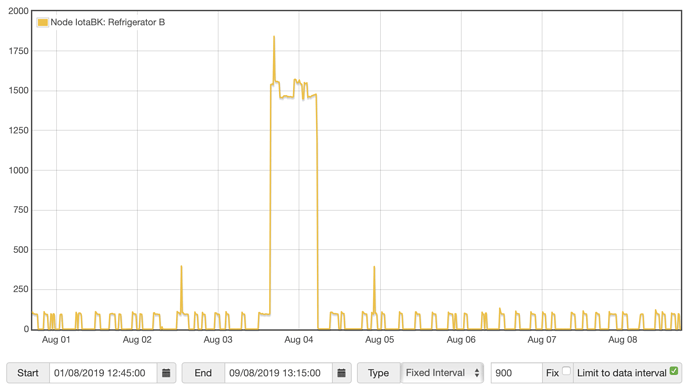I have been monitoring my refrigerator circuit for eight months and just noticed a strange anomaly from four months ago. Typically, the compressor comes on several times a day, drawing 90-100 watts. The ice maker uses a 210 watt resistance heater for 2-3 minutes before dumping ice. However, on August 4 at 11:30am, a steady ~1500 watt load appeared and remained for about 14 hours. The refrigerator compressor and ice maker appeared to continue functioning normally during that time.
At first I assumed it was a measurement error of some sort because the refrigerator is on a dedicated circuit with nothing else plugged in to that outlet behind the refrigerator. However, a second CT on the mains also recorded the same 1500 watt load. If it was actually a real load, I have no idea what it could have been.
Background and additional information:
My home was built in 1991 in Richmond, Virginia, USA. I believe the electrical code at the time would have required the refrigerator to be on a dedicated circuit. I used a tone generator to confirm that no other outlet inside or outside the house is fed from that circuit. My utility supplies 240v split-phase power. When I set up my IoTaWatt and emonCMS, I called one phase “A” and the other phase “B.” I have a model ECS24200 CTs on each phase of the mains coming into my load center. I then have several model ECS1050 CTs on individual circuits. The refrigerator is a 120v circuit on phase B and the mysterious load showed up on both the refrigerator CT as well as the phase B mains CT. My IoTaWatt is currently on firmware version 02_04_02 and has always been set to MINOR auto-update class.
The average outdoor temperature that day was 80°F (27°C) with a high of 91°F (33°C) and a low of 73°F (23°C). Nobody was home when the mystery load started at 11:30am and the security system was armed so it is highly unlikely that anyone entered the home during the day. My partner returned home around 9-10pm that evening but did not notice anything unusual (no smell of smoke, no thawed food in the freezer, etc.). In fact, I only noticed this anomaly last week when I was looking back at my recorded data.
My refrigerator is a Whirlpool model WRT318FZDM02, manufactured in December 2017. Its full load amp rating is 6.5 @ 115V, which only accounts for 748 watts. The profile of the mystery load appears to be that of an electric resistance heater. However, there are only a few devices in the home that are designed to pull 1500 watts or more.
-
A 10kW backup electric resistance heater in our heat pump air handler is on a dedicated circuit, monitored via a dedicated CT, and did not turn on during that time.
-
The electric oven/range is on a dedicated circuit, monitored via a dedicated CT, and did not turn on during that time.
-
Our electric heat pump water heater is on a dedicated circuit, monitored via two dedicated CTs (IoTaWatt and built-in CT), and is set to “heat pump only” mode so it can only pull about 450 watts.
-
We have a washing machine and heat pump dryer that share a dedicated 240v circuit that I installed myself and are monitored by a dedicated CT.
-
We own one portable 1500-watt space heater which was put away in storage at the time.
Several appliances can pull up to 1100 watts (dishwasher, toaster oven, and pressure cooker) but I can’t think of any more devices that can sustain 1500 watts for 14 hours with no inrush current. I would appreciate any help in solving this mystery. Let me know if I can provide any more helpful information.
Here are four screenshots from emonCMS:
This one shows the one shows entire 8 months of historical data on the refrigerator circuit:
This one shows the phase B mains, refrigerator, dishwasher, and heat pump (indoor and outdoor units combined) during the time period in question:
This one shows just the refrigerator circuit during that time:
The mystery load started abruptly with no inrush current but ended in a strange intermittent way. This shows the intermittency at the end of the mystery load:





